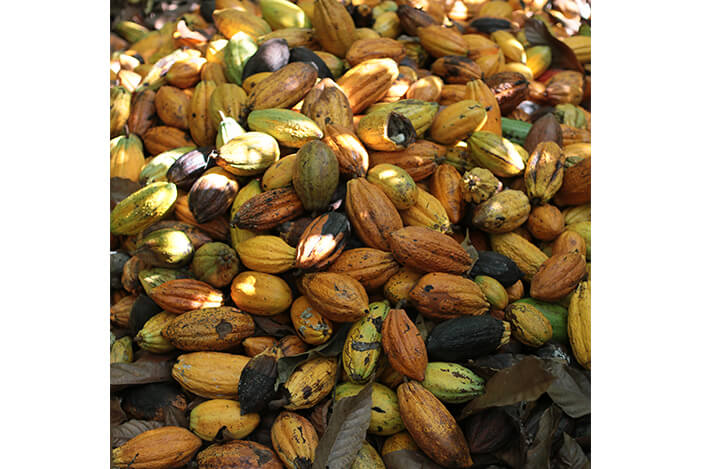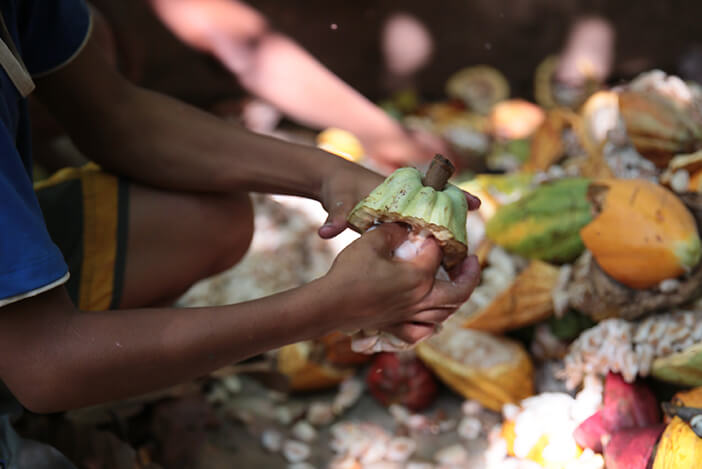Data are from ILO (International Labour Organization) report, prepared in partnership with Labor Prosecution Office
In our imaginary, chocolate is always synonym for pleasure, rather than suffering. Unfortunately, this is not exactly the reality. From July 2017 to June 2018, Papel Social company, hired by ILO and MPT (Labor Prosecution Office), went to visit the main Brazilian cacao poles, Bahia and Pará. The objectives were to understand the production chain dynamics, identify the main players and eventual existence of child and slave labor, among others. The study identified good practices, as well, showing that it is possible to produce cacao in the country in a sustainable way, from the social point of view.
The fact is that the study also indicated significant presence of child and slave labor in cacao plantations, and due to that, the three main international mills operating in Brazil, Barry Callebaut www.barry-callebaut.com, Cargill Cacau www.cargillcacauechocolate.com.br and Olam Brasil www.olamgroup.com are being called to a meeting on June 25, in Brasília, at the ILO seat, to discuss the types of actions to be taken to eradicate child labor and slave-like labor in the Brazilian chocolate production chain.
Labor Prosecutor and National Coordinator of MPT’s CoordInfância Patrícia de Mello Sanfelici emphasized that it will be a work meeting within a friendly environment. “Cacao production chain is complex and MPT is working to make companies adopt really efficient control instrument to make child and slave-like labor disappear. We believe that, if the whole chain undertakes to extinguish the problem, it will be much more productive to the country. In addition to the industry, public authorities must also undertake so that states, municipalities and the Union can provide solutions, chiefly in education. Moreover, it is an intelligent way of eradicating the problem, since there is no evidence of direct participation of mills. “They are co-responsible”, argues the Prosecutor.

The coordinator of ILO Child Labor prevention and eradication area, Maria Cláudia Mello Falcão, on the other hand, says that on June 25 a dialogue table will take place. “Our idea is to form a cacao work group with participation of these large companies, also involving producers, municipal and state governments and the Federal Government. We want a single plan where each one is accountable for a given activity. This is a new methodology we are adopting, because we understand that there is no point in each one doing anything. For example, someone goes there, builds a school and includes it in its Social Report, but we want to go beyond it. We want effectiveness in actions”, she explains.
Tax evasion – an important aspect raised by the study is tax evasion with trading of cacao bean without invoicing. This practice interferes with revenue of counties and state. The report says: “it is considerable the amount of cacao production that leaves the state without proper collection and inspection. Evasion is associated to the work of mediators in the chain, the middlemen. Evasion renders more difficult the tracking of the chain, because it makes impossible to determine the product’s origin, and that favors the concealment of child labor. Evasion has direct impact on the quality of life of cities that integrate the production poles”.
Positioning of mills
Cargill Cacau positioned itself through a note saying that “it will participate in the Cacao Production Chain Dialogue Table on June 25, represented by the National Association of Cacao Processing Industries (AIPC). It also reinforces that it keeps on promoting sustainability policies and taking daily measures to nourish people and protect the planet. The Company’s history shows solid progress by means of constructive partnerships to face these challenges and generate positive and lasting changes in the whole industry”.
Barry Callebaut, on the other hand, through note, said that “as part of the plan to make the whole chocolate produced sustainable by 2025, it undertook to eradicate from its value chain the worst forms of child labor as defined by ILO. And that includes not only cacao, but all chocolate ingredients as well. To reach this objective, Barry Callebaut identified products and origins and where there is risk of having the worst forms of child labor in its value chain, and, through Forever Chocolate Project, is implementing programs to eliminate any form of child labor not compliant with ILO”.
Olam did not return our contacts.
Report data
According to the Report, around eight thousand children and adolescent work in cacao plantations in Brazil. Child labor is more used to separate cacao beans inside the fruit. Older children and adolescents, on the other hand, work in the cut of cacao trees branches, using an adapted large knife, with longer handle. Then they collect the fruit from the ground and place in a straw basket that they carry on their back. Full baskets may weigh up to 20kg.

Also according to the report, there are around 120 thousand cacao producers in Brazil, most of them from family agriculture, and they can’t afford employees. Then, chiefly at harvest time, the child or adolescent is in charge of the task, skipping classes at school. The low price paid by middlemen is one of the factors that lead to child labor, also according to the document.
It was also observed that counties that produce cacao present HDI (Human Development Index) inferior to state and national averages, which shows the vulnerability of their population.
The sector in numbers
The cacao and chocolate sector is a global operation involving few companies but deals with US$ 110 billion a year, according to Euromonitor data. Around 5.5 million of small farmers account for the world cacao production, but only nine companies execute milling of beans. According to data from International Cocoa Organization (ICCO) disclosed in May 2018, the world production in 2017/17 crop was estimated in 4.7 million tons. Ivory Coast is the largest world producer with around two million tons, accounting for 42.5% of the global production. Brazil is in second position as largest producer in South America, behind Ecuador, and seventh largest in the world, with participation corresponding to 3.7% of the whole world production in 2017. Brazilian production reached 235,809 tons in 2017.
Good practices exist
The Report also indicates three farms, two in Pará and one in Bahia, which adopt good practices and can be used as management model. They are: Camduru, in Bahia and Panorama and Sítio Dia Lindo, in Pará.
The study did not identify Bean to Bar movement
In addition to the report, Papel Social produced photos and a video, presented in Harvard by Anthropology and African Studies Professor PHD Carla D. Martin to her students in the beginning of this year. Carla is also founder and executive director at Fine Cacao and Chocolate Institute (FCCI), www.chocolateinstitute.org, a nongovernmental organization dedicated to identify, develop and promote fine cacao and chocolate..
The presentation of the video alone caused discomfort in Brazil to some members of the chocolate and cacao chain.
Bean to Bar Brasil, www.beantobarbrasil.com.br, association that gathers makers of artisanal chocolate in Brazil, some of which also cacao producers, heard about the study by Dr. Carla Martin and, taking the opportunity of an event held in May in São Paulo, the Bean to Bar Chocolate Week, invited Papel Social executive director, www.papelsocial.com.br, Marques Casara, to present the video and debate with the public. Despite the elegant gesture of Bean to Bar Brasil, some members felt discomfort with the study because they were not heard. Marques Casara replied saying that, unfortunately, Bean to Bar movement was not identified for the work and that he regretted that.
Bean to Bar Brasil association president Arcelia Gallardo stated that Bean to Bar chocolate makers are very responsible, they visit the farms in person, get to know producers and work conditions in special cacao plantations. “Moreover, around half of chocolate-makers that participate in the association are also fine cacao producers, and that they also keep schools for workers children within properties, as is the case of Vale Potumuju www.valepotumuju.com, at southern Bahia. They have this responsibility to be acquainted with the persons they employ. In our industry there is no child or slave-like labor”, she concluded.
Photos: Tatiana Cardeal



